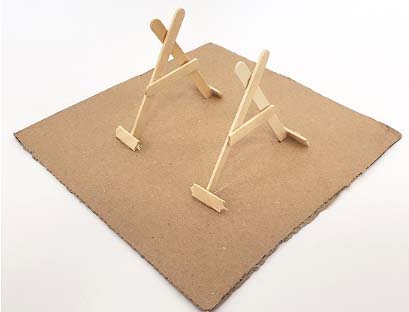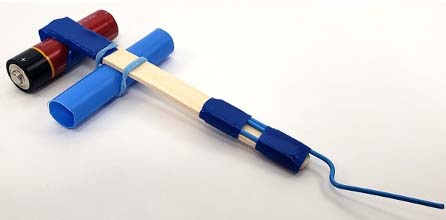Mechanical engineers are part of your everyday life, designing the spoon you used to eat your breakfast, your breakfast’s packaging, the cap on your toothpaste tube, and much more! Virtually every object that you see around you has passed through the hands of a mechanical engineer. Consequently, their skills are in demand to design millions of different products in almost every type of industry.
You probably know what a catapult is. In the Middle Ages armies would use them to hurl stones at castle walls. But did you know about an even bigger type of medieval siege weapon called a trebuchet? Try this project to build a miniature version!
A trebuchet relies on gravitational potential energy—the type of energy you get by raising something up off the ground. A trebuchet design has a lever arm with a large, heavy counterweight on one end and a smaller projectile on the other end. When the counterweight is raised up, it has lots of gravitational potential energy. Then the counterweight is allowed to fall, rotating the lever arm and converting that potential into kinetic energy in the projectile, which is flung through the air. Many medieval trebuchets were larger and could hurl projectiles even farther than catapults.
Trebuchet Design: Materials and Equipment
- Piece of corrugated cardboard, about one foot by one foot
- Popsicle sticks (8)
- Scissors
- Pencil
- Jumbo or “milk shake” or “boba” straw
- Glue (a hot glue gun is best if available but use caution and adult assistance when using hot glue.)
- Tape
- Rubber bands
- String
- Paper clip
- AA Battery
Trebuchet Prep Work
Assemble all your materials in a location that is open and clear of people, animals or breakable objects so that you can test your trebuchet design.
Safety note: Never aim projectiles at people or animals. A toy trebuchet might seem harmless, but even a small projectile can cause eye damage.
If you’re having trouble you can watch a video of the build here:
Procedure
- Note: There is more than one way to build the trebuchet design described in this project. For example, you could decide to build the entire frame out of pencils instead of popsicle sticks and you can choose whether you want to use tape, glue, or rubber bands to secure the different joints. Think of this as an engineering design project—there is no single “right answer” or correct way to build the trebuchet. You can modify your design based on your own ideas and the materials you have available.
- Start out by building the two side A-frame pieces. Take five popsicle sticks and cut one of them in half. Glue the pieces together as shown in the picture, forming an “A” shape with a small notch at the top.
- Carefully cut slots in your piece of corrugated cardboard that will allow your A-frame pieces to stand up straight, a few inches apart from each other. Stick the ends of the A-frame pieces into the slots. Reinforce the connections with glue/tape and some extra popsicle stick pieces if necessary so they remain standing on their own.

- Now you will build the trebuchet’s arm. First, tape the AA battery to one end of a popsicle stick.
- Unbend one end of a paper clip so it is almost, but not quite, straight. Attach the remaining flat part of the paper clip to the other end of the popsicle stick, with the straightened part pointing outward and up (away from the counterweight). This will serve as a hook to hold the “sling,” which in turn holds the projectile.
- Cut a small section of milk shake straw, about one inch long. Attach this perpendicular to the popsicle stick arm using glue, rubber bands, or tape. The straw should be much closer to the counterweight than it is to the hook. (This distance is something you can try adjusting later.)

- Slide the pencil into the milk shake straw.
- Place the pencil into the two V notches on top of your A-frame pieces. Secure it in place with rubber bands. This forms a crossbar and completes your trebuchet’s frame. The straw and pencil form a pivot and should allow the arm to rotate. (We do not recommend using glue for this step—that way you can remove the crossbar and swap out the arm to make changes.)
- Make sure your trebuchet design is sturdy and the frame holds together. Try rotating the arm with your hand. If any of the joints seem weak or the frame wobbles significantly, reinforce them with tape, glue, or rubber bands.
- Remove the eraser from the pencil and attach it to a small loop of string. Hang the eraser from the paper clip hook.
- Now it is time to test your trebuchet. Use one hand to pull down on the eraser. This should raise the counterweight up in the air. Then, making sure no people, animals or breakable objects are nearby, let go.
- Now you might need to tinker with your trebuchet in order to get the best launch. Try pulling the eraser under the trebuchet frame. It is okay if the eraser is resting on the ground and there is slack in the sling. When the counterweight falls, it will drag the eraser along the ground and then pull it up into the air.
What Happened?
When you pull down on the eraser, this causes the battery to lift up in the air, giving it (gravitational) potential energy. When you release the eraser, the battery falls and its potential energy is converted to kinetic energy of the eraser. As the arm swings, the sling holding the eraser slides off the hook and the eraser’s kinetic energy causes it to fly through the air as a projectile.
Depending on exactly how you built your trebuchet, the results you see will vary. Remember that there is no single “correct” way to build the trebuchet. A well-built trebuchet design should be able to hurl an eraser a few feet. Do not get discouraged if at first your trebuchet launches the eraser straight up in the air or fails to release it at all. You should be able to tinker with your design a bit to get your eraser to launch.
- Try using lighter (or heavier) batteries. What impact do you think the weight of the counterweight will have on your projectile?
- Try changing the length of the lever arm. Both the overall length and the ratio between the distance from the pivot to the counterweight and the pivot to the sling. What happens if you move the pivot so it is exactly in the middle of the arm? What if you glue multiple popsicle sticks together to make a longer arm?
- What happens if you make the sling longer or shorter?
- What happens if you bend the paper clip so it is straighter or more curved or if it is cut to be shorter?
- What happens if you use something other than an eraser, such as a small balled up piece of paper?
About the Author
Heather Sheridan P.E., PMP is a Civil Engineer and Project Manager at Black & Veatch in the Hydropower Department. Heather has a BS in Civil Engineering from the University of California, Davis with a focus on hydraulic structures and environmental design.
Author
-

SWE Blog provides up-to-date information and news about the Society and how our members are making a difference every day. You’ll find stories about SWE members, engineering, technology, and other STEM-related topics.






